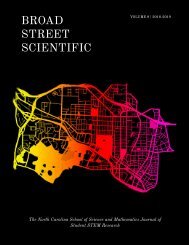Broad Street Scientific Journal 2020
You also want an ePaper? Increase the reach of your titles
YUMPU automatically turns print PDFs into web optimized ePapers that Google loves.
SYNTHESIS OF A TAU AGGREGATION INHIBITOR
RELATED TO ALZHEIMER’S DISEASE
Emma G. Steude
Abstract
A multitargeted approach is suggested to be most effective in inhibiting the formation of tau aggregates in Alzheimer’s
disease. Two promising targets for treatment of Alzheimer’s are the initial hyperphosphorylation of tau, caused by an
overexpression of the GSK-3β protein, and early tau aggregation itself. To improve drug effectiveness, the structure of a
known inhibitor molecule targeting both of these stages of tau aggregation was adjusted to increase binding affinity with
the GSK-3β enzyme. These adjusted molecules were screened using Molegro. The candidate molecules with the highest
calculated binding affinities were further evaluated. One of these novel compounds was then synthesized and assayed for
its ability to inhibit the GSK-3β protein, resulting in a comparable efficacy to the original known molecule’s multitargeted
structure. The novel molecule has promising GSK-3β inhibition results and maintained structural features to attack
early tau aggregation. This indicates possible effectiveness in inhibiting the future stages of tau aggregation indicative of
Alzheimer’s disease.
1. Introduction
According to the Alzheimer’s Association [1], one in
ten Americans aged 65 and older have Alzheimer’s disease.
The neural damage from Alzheimer’s disease can result in
severe memory loss, degradation of motor functions, and
eventual death. Despite the severity of the disease, there is
currently no cure. This is partly because a specific target
has yet to be definitively identified and experimentally determined
to cause Alzheimer’s disease. Currently, the two
most researched explanations are the amyloid hypothesis
and the tau hypothesis. The amyloid hypothesis suggests
that amyloid-β aggregates to create plaques that disrupt
normal neuron communication at the synapses. However,
none of the developed amyloid beta-targeted drugs have
proven to stop or even slow disease progression [2]. More
recently, the tau hypothesis is being researched. Tau is
thought to disrupt transport in the neuron itself and may
be a more promising target for prevention of Alzheimer’s
disease.
The tau protein is located along the axon of neural cells
and is complex, having six isoforms. In healthy brains, tau
functions to aid transport of signals across the axon of
neurons in the brain. In the brains of Alzheimer’s disease
patients, however, tau hyperphosphorylates, causing the
tau to break from the microtubule that it was stabilizing.
Drifting from its usual position near the axon, the tau protein
can then form aggregates with other hyperphosphorylated
tau proteins [3]. The formation of tau aggregates is
thought to be a significant factor in causing Alzheimer’s
disease.
There are, in fact, multiple levels of tau aggregation
and, consequently, multiple targets for drug design. Hyperphosphorylated
tau proteins may aggregate to form
β-sheets, which later aggregate to form oligomers. Soluble
oligomers then form insoluble paired helical filaments
(PHF), which further aggregate to form neurofibrillary
tangles [3]. Researchers are still unsure which specific aggregation
level would cause Alzheimer’s disease, but experimental
correlation suggests that overall aggregation
plays a significant role in the progression of the disease.
As there is no direct target for disease treatment, focusing
on early stages of the aggregation process may be the
best alternative. The inhibition of early aggregation may
prevent subsequent, more complex aggregates from forming.
Furthermore, targeting multiple steps of aggregation
with a multitargeted drug may be more effective in preventing
the disease than targeting a single stage. The hyperphosphorylation
stage and the early levels of aggregation
itself are two plausible targets. Drug interaction with
these targets can be tested with the GSK-3β protein and
the AcPHF6 peptide. GSK-3β is a kinase that, when overexpressed,
hyperphosphorylates the tau protein, enabling
tau to aggregate. The AcPHF6 peptide, on the other hand,
is a segment of the tau protein that models aggregation.
This peptide is involved in both the microtubule-binding
property of normal tau as well as PHF formation in hyperphosphorylated
tau. Therefore, one can inhibit many
stages of tau protein aggregation by inhibiting the GSK-
3β protein’s hyperphosphorylation of tau and by inhibiting
the early aggregation shown through the AcPHF6 peptide.
In essence, by targeting tau aggregation at two early levels,
further aggregation may be effectively inhibited [4].
Previous research used Thiadiazolidinedione (TZD) as
a lead compound to identify candidate compounds that act
against both the GSK-3β protein and the AcPHF6 peptide
[4]. One derived molecule, Model 30 [4] was promising
for multitargeted tau inhibition (Fig. 1). It was suggested
that structural adaptations at the R1 and R2 positions
could further increase the efficacy of this molecule. With
these adaptations, the compound is hypothesized to more
effectively inhibit tau aggregation at the GSK-3β target
46 | 2019-2020 | Broad Street Scientific CHEMISTRY




